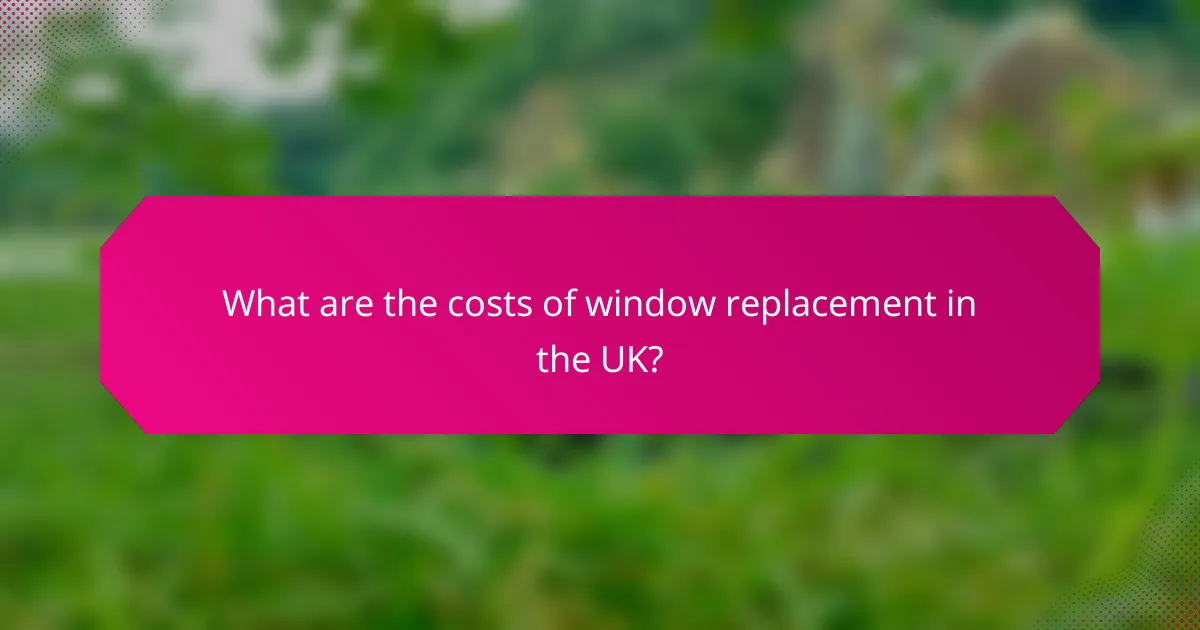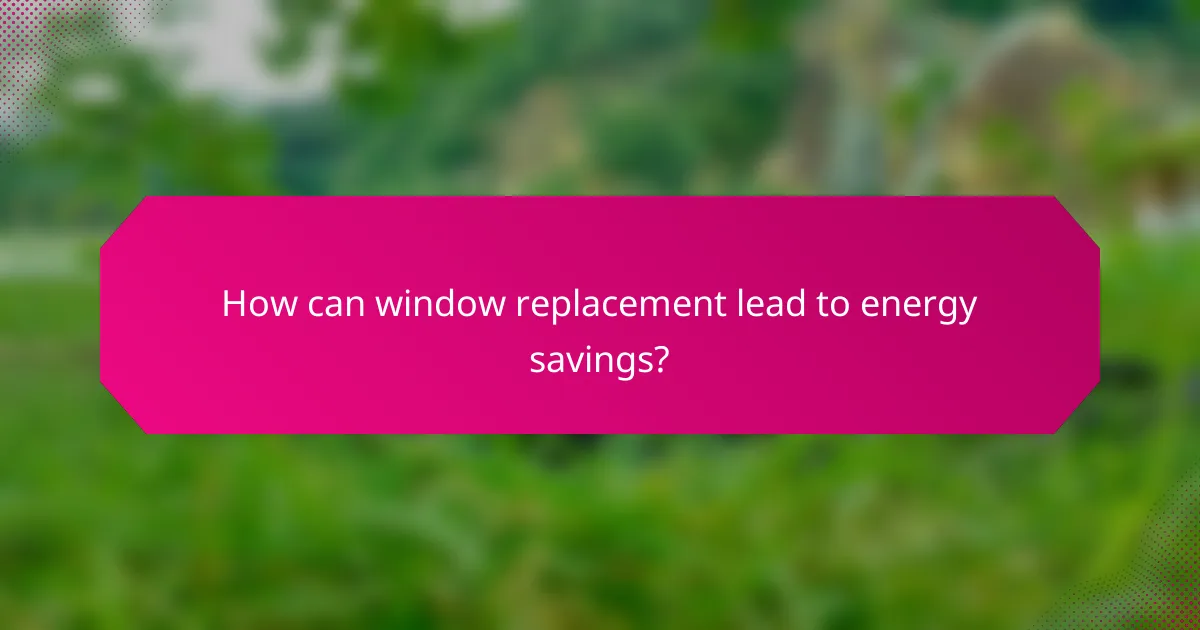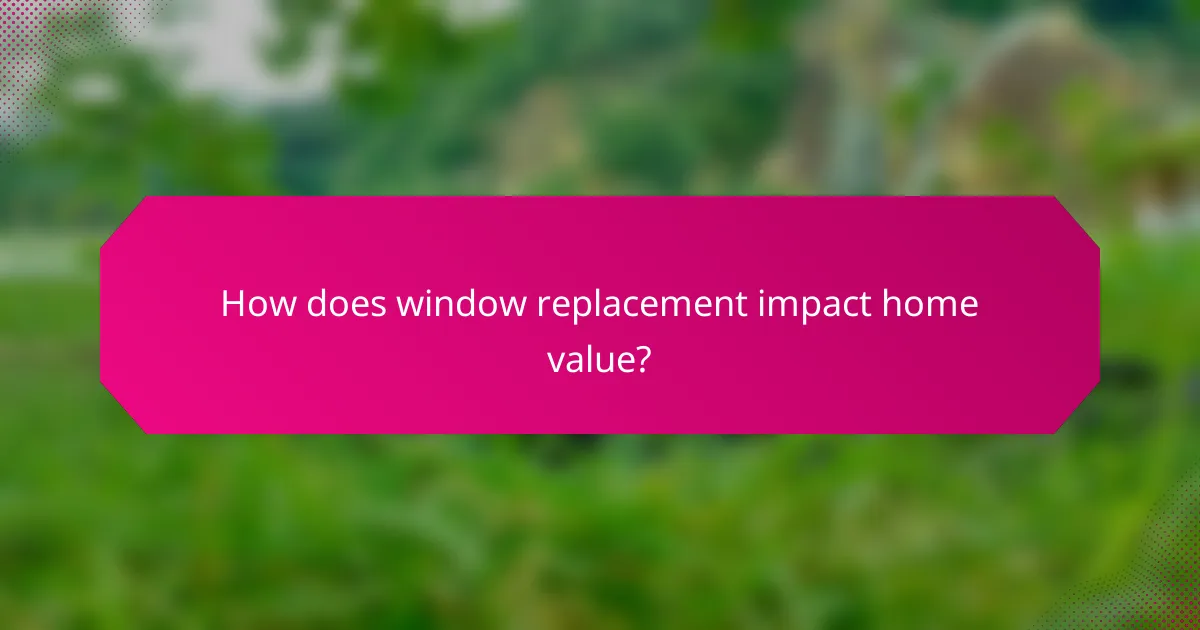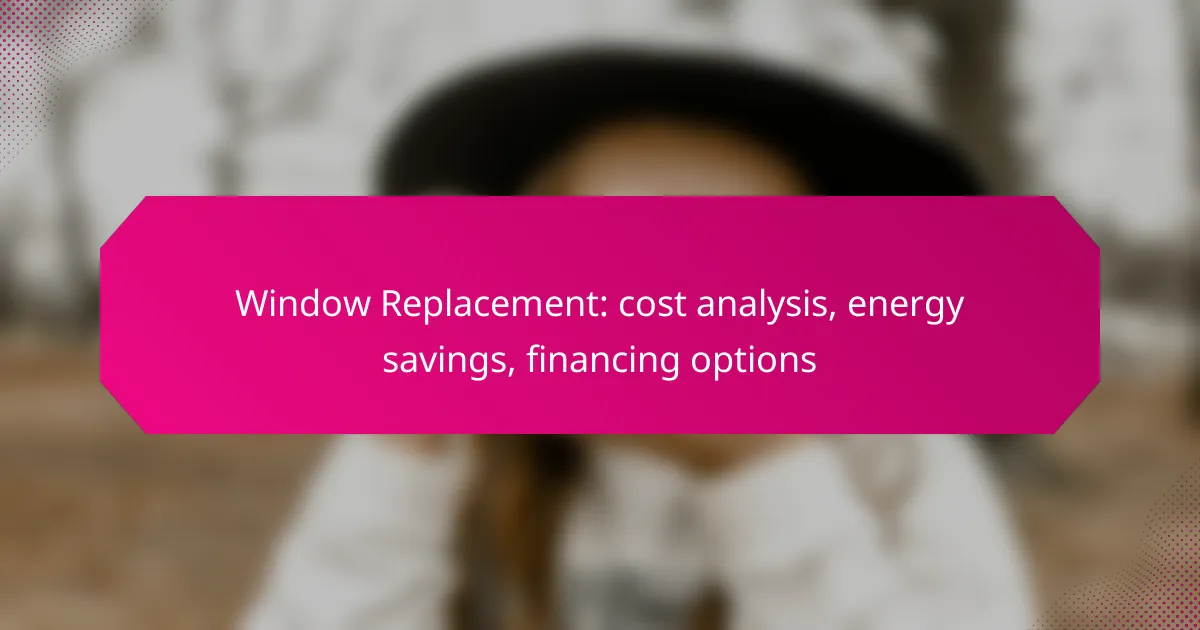Replacing windows can be a significant investment for homeowners, with costs ranging from £300 to £1,000 per window depending on various factors. However, the benefits of upgrading to energy-efficient windows extend beyond aesthetics, as they can lead to substantial savings on heating and cooling bills. Additionally, there are various financing options available, such as government grants and home improvement loans, to help manage the costs and enhance property value.

What are the costs of window replacement in the UK?
The costs of window replacement in the UK can vary significantly based on several factors, including the type of windows, installation complexity, and location. Generally, homeowners can expect to spend anywhere from £300 to £1,000 per window, including both materials and labor.
Average installation costs
On average, the installation costs for window replacement in the UK range from £400 to £800 per window. This price typically includes the cost of the window itself, installation labor, and any necessary materials. For larger projects or specialized windows, costs can increase substantially.
It’s advisable to obtain multiple quotes from local contractors to ensure competitive pricing. Be sure to check what is included in the quote, such as removal of old windows and cleanup after installation.
Factors affecting pricing
Several factors can influence the pricing of window replacement, including the window frame material, glass type, and energy efficiency ratings. For instance, uPVC frames are often less expensive than timber or aluminum options.
Additionally, the complexity of the installation can affect costs. If structural modifications are needed or if the windows are in hard-to-reach areas, labor costs may rise. Geographic location also plays a role, as urban areas tend to have higher labor rates than rural regions.
Cost comparison by window type
Different types of windows come with varying costs. For example, standard double-glazed uPVC windows typically start around £300, while triple-glazed windows can range from £600 to £1,200. Timber windows generally fall between these two ranges, depending on the quality and design.
When considering window types, also factor in long-term energy savings. Higher initial costs for energy-efficient windows may be offset by reduced heating bills over time. Always evaluate the total cost of ownership, not just the upfront investment.

How can window replacement lead to energy savings?
Window replacement can significantly enhance energy efficiency by reducing heat loss in winter and minimizing heat gain in summer. Upgrading to modern, energy-efficient windows can lower heating and cooling costs, leading to substantial savings over time.
Energy-efficient window options
When considering energy-efficient windows, look for options that feature double or triple glazing, low-emissivity (Low-E) coatings, and argon gas fills. These features help insulate your home better than standard single-pane windows. Popular materials include vinyl, fiberglass, and wood, each offering different levels of insulation and durability.
Energy Star-rated windows are a reliable choice, as they meet strict energy efficiency guidelines set by the U.S. Environmental Protection Agency. Investing in these windows can lead to better performance and potential rebates or tax credits depending on local regulations.
Long-term savings on energy bills
Replacing old windows with energy-efficient models can lead to long-term savings on energy bills. Homeowners can expect a reduction in heating and cooling costs, often ranging from 10% to 25%. The exact savings will depend on factors such as local climate, energy prices, and the efficiency of the new windows.
To maximize savings, consider the payback period for your investment. While energy-efficient windows may have a higher upfront cost, the long-term reduction in energy expenses can make them a financially sound choice over time.
Environmental benefits of energy-efficient windows
Energy-efficient windows contribute to a reduced carbon footprint by lowering energy consumption. By using less energy for heating and cooling, homes can decrease their reliance on fossil fuels, which helps mitigate climate change. This is particularly important as many regions are striving to meet sustainability goals.
Additionally, energy-efficient windows can enhance indoor comfort by reducing drafts and maintaining consistent temperatures. This not only benefits the environment but also improves the quality of life for residents by creating a more pleasant living space.

What financing options are available for window replacement?
Several financing options exist for window replacement, including government grants, home improvement loans, and various credit options. These alternatives can help homeowners manage the costs associated with upgrading their windows, often leading to energy savings and increased property value.
Government grants and incentives
Government grants and incentives can significantly reduce the financial burden of window replacement. Many local and federal programs offer funding or tax credits for energy-efficient upgrades, which can cover a portion of the costs. Homeowners should check with their local energy office or visit government websites to find available programs.
For example, the U.S. federal government has offered tax credits for energy-efficient windows, which can provide savings of up to a few hundred dollars. Eligibility often depends on the window’s energy performance ratings, so it’s essential to verify specifications before purchasing.
Home improvement loans
Home improvement loans are another viable financing option for window replacement. These loans can be secured through banks or credit unions and typically offer fixed or variable interest rates. Borrowers can often finance the entire cost of the window project, making it easier to manage cash flow.
Common types of home improvement loans include personal loans and home equity loans. Personal loans generally have higher interest rates but do not require collateral, while home equity loans use the homeowner’s equity as security, often resulting in lower rates.
Credit options for homeowners
Homeowners can also consider credit options such as credit cards or specialized financing programs offered by window manufacturers. Some credit cards offer promotional financing with low or zero interest for a limited time, which can be beneficial for managing upfront costs.
Additionally, many window companies provide financing plans that allow homeowners to pay over time, often with competitive interest rates. It’s crucial to read the terms carefully and understand any fees or penalties associated with late payments to avoid unexpected costs.

What are the prerequisites for window replacement?
Before replacing windows, homeowners should assess their current window conditions and understand local building regulations. These steps ensure a smooth replacement process and compliance with any legal requirements.
Assessing current window conditions
Begin by inspecting your existing windows for issues such as drafts, condensation, or rot. These signs indicate whether replacement is necessary or if repairs can extend their lifespan.
Consider the age and style of your windows. Older windows may not meet modern energy efficiency standards, making replacement a more viable option. If your windows are single-pane, upgrading to double or triple-pane glass can significantly enhance insulation.
Understanding local building regulations
Familiarize yourself with local building codes that govern window replacements. These regulations may dictate specific materials, sizes, or energy efficiency ratings that your new windows must meet.
Check if a permit is required for your project. Many municipalities require permits for window replacements to ensure safety and compliance with energy standards. Contact your local building department for guidance on the necessary steps and documentation.

How do different window materials compare?
Different window materials have unique characteristics that affect their cost, energy efficiency, and maintenance needs. Understanding these differences can help homeowners make informed decisions when replacing windows.
Vinyl vs. wood windows
Vinyl windows are generally more affordable and require less maintenance than wood windows. They are resistant to moisture and do not warp or rot, making them a practical choice for many climates.
On the other hand, wood windows offer better insulation and aesthetic appeal, often increasing a home’s value. However, they require regular maintenance, such as painting or staining, to protect against the elements.
Aluminium window benefits
Aluminium windows are known for their strength and durability, making them ideal for larger openings. They are resistant to corrosion and require minimal maintenance, which can be advantageous in coastal areas.
Additionally, aluminium frames can be thermally broken to improve energy efficiency, reducing heating and cooling costs. While they may have a higher upfront cost compared to vinyl, their longevity and low maintenance can make them a cost-effective option over time.

What are the latest trends in window technology?
The latest trends in window technology focus on enhancing energy efficiency and integrating smart features. Innovations such as smart windows and advanced insulation methods are becoming increasingly popular, offering homeowners better control over energy consumption and comfort.
Smart windows and energy management
Smart windows utilize advanced technologies to adjust their tint based on sunlight exposure, helping to regulate indoor temperatures. These windows can be controlled manually or automatically, allowing for significant energy savings by reducing the need for heating and cooling systems.
Homeowners can expect to see energy savings of around 10-30% depending on usage patterns and local climate. Investing in smart window technology may involve higher upfront costs, but the long-term savings on energy bills can make it worthwhile.
Innovations in window insulation
Recent advancements in window insulation include triple glazing and low-emissivity (Low-E) coatings, which significantly enhance thermal performance. Triple-glazed windows provide an additional layer of insulation compared to double-glazed options, making them ideal for colder climates.
When selecting insulated windows, consider factors such as the U-factor and solar heat gain coefficient (SHGC) to ensure optimal energy efficiency. While these windows may come with a higher price tag, the potential for reduced energy costs and increased comfort can justify the investment over time.

How does window replacement impact home value?
Window replacement can significantly enhance a home’s value by improving its energy efficiency and curb appeal. Homebuyers often prioritize modern, well-maintained windows, which can lead to higher offers and quicker sales.
Market trends in property value
Current market trends indicate that homes with energy-efficient windows tend to sell for higher prices compared to those with outdated or damaged windows. Many buyers are looking for properties that offer long-term savings on energy bills, making window upgrades an attractive feature.
In regions with extreme climates, the impact of window replacement on property value can be even more pronounced. For instance, homes in colder areas may see a greater return on investment from energy-efficient windows, as they help reduce heating costs significantly.
Investing in high-quality windows can yield returns of around 70-80% of the initial cost upon resale. Homeowners should consider local real estate trends and consult with real estate agents to understand how window improvements can influence their specific market.
